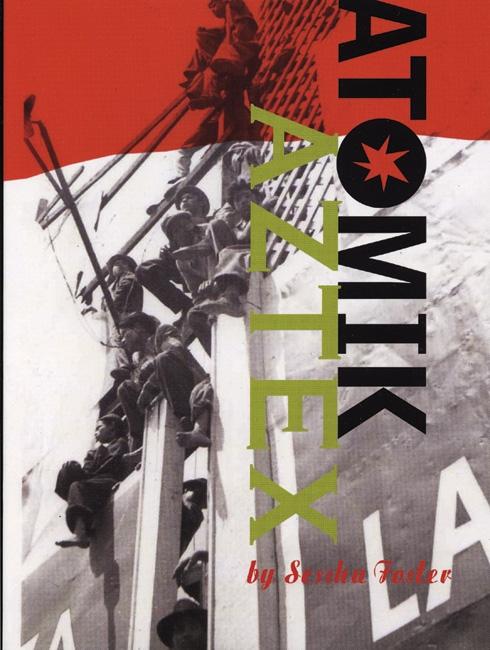Q & A(te): Sesshu Foster’s ATOMIK AZTEX
by Karen Sims · April 13, 2022
Welcome to the first of our new series, Q & A(te), where we interview authors about the way food, dining, and eating intersect with craft. Our first guest, novelist and poet Sesshu Foster, is the author of City Terrace Field Manual, American Loneliness, and World Ball Notebook. His poetry also appears in numerous anthologies and journals. We spoke about his experimental, speculative, and transnational novel Atomik Aztex, published in 2005, covering everything from colonization to ume onigiri.
What was the last meal you ate?
The last meal I ate was the dinner I cooked: baked chicken, butterflied, marinated in lemon juice, Huy Fong garlic Chile sauce and garlic on the underside, and dry-rubbed with cayenne, cumin, Chile powders on top; served with steamed zucchini and garlic sourdough bread.
Let’s chat colonization–One of the overarching themes of Atomik Aztex is the intergenerational trauma and damage caused by colonization and imperialism. This is explored most obviously through the parallel narratives of “Zenzontli” and “Zenzon.” However, food in the text also seems to be a commentary on the legacy of conquest, violence, and forced globalization, with produce such as maize, chocolate, chilies, and tomatoes described as stolen “intellectual kapital” (89). What are your personal experiences and philosophies regarding the relationship between food and colonization?
Personal experiences—-
Let me relate 2. First, I’m 64, so I’ve seen foods that people eat daily change over the past four or five decades. When I was growing up, the American “white bread” diet seemed terribly narrow and basically terrible—-meat and potatoes and Wonder bread and dairy products. I remember when white people would, as a matter of course, express disgust that Japanese Americans ate raw fish. Imagine that now, when there’s a sushi place (and too many of them) everywhere. Also, the diaspora of Mexican workers across North America means that Mexican restaurants providing good regional cooking (not merely greasy orange cheese slopped on Taco Bell ground beef) have spread coast to coast, with white people regularly commenting on Yelp about how good or how “authentic” the burritos are. That is to say, diverse immigrants have enriched the American diet in good ways.
Secondly, travels in Mexico revealed to me how homogenized most commercial “Mexican” food is that is provided in restaurants—-like the chop suey menus in Chinese restaurants of the 1960s. Travel the width and breadth of Mexico, with its 62-plus indigenous languages, it reveals the depth and diversity of Mexico’s great contributions to world food—-tomatoes, corn, chiles, chocolate, avocados and ideas. If you visit Oaxaca you can taste unbroken traditions of ten thousand years.
Philosophies—-
Thirty and forty years ago, Wendell Berry and Frances Moore Lappe were writing about plant-based and organic agriculture that is common knowledge among foodies and the food movement nowadays. Of course, these ideas simply go back to indigenous food ways that are being “rediscovered” and accepted as forms of wisdom.
What is a dish that feels like your childhood?
PB and J, that was the staple of my childhood, but the lunch item that reminds of of my childhood is rice balls, a ball of packed rice with salty red ume pickled plum in the center—-because the other kids didn’t get that for lunch. And later, neither did I.
Labor and workers’ rights are another through line of Atomik Aztex. In addition to the narrative arcs of organizing and workplace politics, many striking scenes take place in the Blue Hen Diner, a working-class restaurant close to the factory. Coffee, which is associated with productivity, also makes several appearances in the text, often scalding or burning its drinkers (while also revitalizing them). In what way do you connect food and labor in your creative work?
I’m grateful to the contemporary food movement for connecting industrial agriculture and the conditions that plants and animals are grown in to the conditions that farm workers labor in. The United Farm Workers organized campaigns repeatedly for decades to educate people about the dangers of pesticides and herbicides to both farm workers and to people living near industrial farms. But consumerism always hides the downside, the consequences and the ill-effects of capitalism from consumers because awareness inhibits consumption. Food and labor are connected in my work because the actual relationship of each to the other is rendered invisible in the dominant culture. In general, literature depicts invisible realms—-psychological, spiritual, emotional, and in the case of food and labor in my work, economic and historical. History is real of course, but most often purposely hidden or erased.
What is a dish you serve to your loved ones?
I concluded one of my books, World Ball Notebook, with a made-up recipe for menudo that I actually used to serve to a full house until better cooks took over. Nowadays I like to barbecue a chicken or 2 (see above).
Hot Dog Violence–Where to begin with Farmer John’s! Early in the narrative, Zenzon attempts to connect with his children, gifting them each a basket of processed meat products from the factory where he works. Later, it is implied that Max/Maxtla has been sacrificed into the hot dog pulp, causing death and sickness to its consumers. How do you feel about the meat industry in this country? How do you feel about the exploitation/endangering of kill floor workers throughout American history, or about their role as “front line workers” during the pandemic?
Like I say, the heroic work that essential workers do 24/7, day in and day out, sun-up to sundown in the fields and on the food line is generally erased and made invisible. Foster Farms and Tyson chicken workers died by the dozens or hundreds to bring chicken to market. People are encouraged by advertizing to not think of things that they stuff in their mouth as having a human history, a human and environmental economy. Consumerism wants people to not think. Don’t think. Just consume. Never consider others—-just focus on your own infantilized satisfactions. If you have to think, consumerism wants you to imagine a class-based fantasy of fine wines and fine dining, as somebody put it about an actual $179 bottle of wine at Costco, “a gorgeous nose of blueberry and blackberry liqueur, pen ink, graphite, new saddle leather and barrique.” Mmmm—-graphite and new saddle leather, $179. Oh yeah.
What is a meal that brings you comfort or healing?
Every meal brings me some comfort and ‘healing.’ I’m a good eater, whether it’s a homemade egg salad sandwich I eat while driving 800 miles from L.A. to Oregon, or handfulls of trail mix and cold water on a mountain.
Form–Atomik Aztex is an experimental novel, with shifting perspective, disorientation, poetic catalog, and stream of consciousness working in effective and poetic ways. How does food interact with this form? What are the benefits of experimenting with food and food imagery alongside non-traditional prose styles?
As Viktor Shklovsky says, writers experiment in (ostranenie) order to defamiliarize readers with realities or experiences that people have grown insensitive to and no longer see because they (we) take too much for granted. “A rose is a rose is a rose is a rose” not. The purpose in general is to re-sensitize people to life and renovate imaginations colonized by the bullshit products of Hollywood. Food interacts with the style of Atomik Aztex by providing the allusive context of counter-narratives that are not Eurocentric or consumer-colonialist.
What have you been craving lately, in food, writing, or life in general?
In this pandemic period, I miss spur of the moment travel to crowded places, jumping on the Gold Line to get off in Little Tokyo and push through downtown L.A.’s jam-packed Grand Central Market to eat excellent ceviche tostadas at La Tostaderia, or wander crowded marketplaces in far-flung cities sampling bowls of hot soup. I wish I could hang out with my daughter in New York and pick up a bag of bagels in Brooklyn, hit that food court in Flushing or whatever she felt like.
Anything else you would like to add!
Yeah, I’d like to suggest readers pick up the recent books by poet Angel Dominguez, RoseSunWater (2021) and Desgraciado: the Collected Letters (2022) each of which in radically different ways engages in an overtly decolonizing poetics that is inspiring, useful and courageous. Angel Dominguez brings it—check it out.
Also, it won’t be released till April, but pick up Lisa Hsiao Chen’s brilliant novel, Activities of Daily Living which—as implied by the title—is both a meditation upon the ordinary acts of daily life as well as a kind of provocation, to cause us to reconsider “ordinary” time in our own lives.
Finally, only lately has the Los Angeles performance art group ASCO (1971 – 1987) received some long overdue recognition. This means ASCO gets exhibited in Europe more often than the USA. Lost in the interim or mostly unnoticed are the writings of ASCO cofounder Harry Gamboa Jr. collected by the University of Minnesota Press in 1998 [titled] Urban Exile: the Collected Writings of Harry Gamboa Jr. Harry’s writings are boldly Chicano, satirically documentary, and irreverently urban. Global warning before global warming.
Sesshu Foster

Karen Sims is a PhD candidate and Graduate Teaching Assistant at Georgia State University. Her fiction, creative nonfiction, and food writing have appeared in McSweeney’s Internet Tendency, MSU Roadrunner Review, Put A Egg On It, and others. Her story “Raohe Night Market” won the 2024 Steven R. Guthrie Memorial Writers’ Festival Contest in fiction. Originally from Taiwan, she also publishes under the name 蘇祺 Suqi Karen Sims. Her research interests include nonwestern narratives, myths, and food as literary device. She is an Assistant Editor at Five Points.


